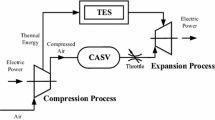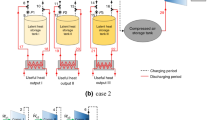Abstract
The integration and accommodation of the wind and solar energy pose great challenges on today’s power system operation due to the intermittent nature and volatility of the wind and solar resources. High efficient large-scale electrical energy storage is one of the most effective and economical solutions to those problems. After the comprehensive review of the existing storage technologies, this paper proposes an overall design scheme for the Non-supplementary Fired Compressed Air Energy Storage (NFCAES) system, including system design, modeling and efficiency assessment, as well as protection and control. Especially, the design principles of the multistage regenerative, i.e. heat recovery system which is used to fully recycle and utilize the waste heat from compression are provided, so as the overall system efficiency evaluation method. This paper theoretically ascertains the storage decoupling rules in the potential and internal energy of molecular compressed air and reveals the conversion mechanism of gas, heat, power, electricity and other forms of energy. On this basis, a 500-kW physical simulation system of CAES system (TICC-500, Tsinghua-IPCCAS-CEPRI-CAES) is built, which passed a system-wide 420-kW load power generation test with less pollution and zero carbon emissions. Besides, the multi-form energy conversion of multi-stage regenerative CAES and storage efficiency is verified, especially its incomparable superiority in solving the uncertainty problem in wind and solar power generation. Finally, the propaganda and application scenario of the CAES system in China is introduced.
Similar content being viewed by others
References
Wang N B. Transmission and Consumption of Large-scale Wind Power. Beijing: China Electric Power Press, 2012
Zhang L Y, Ye T L, Xin Y Z, et al. Problems and measures of power grid accommodating large scale wind power. P CSEE, 2010, 25: 1–9
Xie Y G, Jiang X D. Impact of energy storage system on the unit commitment problem with volatile wind power. Autom Electr Pow Syst, 2011, 5: 19–24
Lu Q, He G Y, Mei S W, et al. AEMS and its trial operation in Shanghai electric power grid. Sci China Ser-E Tech Sci, 2008, 51: 476–480
He G Y, Sun Y Y, Ruan Q T, et al. Revolution of modern power system dispatch and control-from EMS to AEMS. Sci China Ser-E Tech Sci, 2009, 52: 729–734
Zhang W L, Qiu M, Lai X K. Application of energy storage technologies in power grids. Power Syst Tech, 2008, 7: 1–9
Chen L J, Mei S W, Wang J J, et al. Smart grid oriented large-scale compressed air energy storage technology. Adv Tech Elec Eng Energ, 2014, 6: 1–6
Wang H, Wang L, Wang X, et al. A novel pumped hydro combined with compressed air energy storage system. Energies, 2013, 6: 1554–1567
Bullough C, Gatzen C, Jakiel C, et al. Advanced adiabatic compressed air energy storage for the integration of wind energy. In: Proceedings of the European Wind Energy Conference. London, 2004. 22–25
Nakhamkin M, Chiruvolu M, Daniel C. Available compressed air energy storage (CAES) plant concepts. Energy, 2010, 4100: 81
Kim Y, Lee J, Kim S, et al. Potential and evolution of compressed air energy storage-energy and exergy analysis. Entropy, 2012, 14: 1501–1521
Daneshi H, Srivastava A K. Security-constrained unit commitment with wind generation and compressed air energy storage. IEE P-Gener Transm D, 2012, 6: 167–175
Liu W Y, Yang Y P, Song Z P. Optimization and performance simulation of different CAES systems. J Eng Thermophys, 2005, S1: 25–28
Wang. Z J, Chen. L J, Mei. S W, et al. Optimal capacity configuration method of distributed compressed air energy storage in wind farm. In: Proceedings of 33rd Chinese Control Conference (CCC). Nanjing: Chinese Control Conference, 2014. 7516–7520
Díaz-González F, Sumper A, Gomis-Bellmunt O, et al. A review of energy storage technologies for wind power applications. Renew Sust Energ Rev, 2012, 16: 2154–2171
Chen H, Cong T N, Yang W, et al. Progress in electrical energy storage system: A critical review. Prog Nat Sci, 2009, 19: 291–312
Inage S. Prospects for Large-Scale Energy Storage in Decarbonised Power Grids. Paris: International Energy Agency, 2009
Suntainx. SustainX’s ICAES. http://www.sustainx.com/technology-isothermal-caes.htm, 2013
Chen H S, Liu J C, Guo H, et al. Technical principle of compressed air energy storage system. Energ Storage Sci Tech, 2013, 2: 146–151
Zhang X J, Chen H S, Liu J C, et al. Research progress in compressed air energy storage system: A Review. Energ Storage Sci Tech, 2012, 01: 26–40
Ni Y X, Chen S S, Zhang B L. Theory and Analysis of Dynamic Power Systems. Beijing: Tsinghua University Press, 2002
Li J P. Dynamic Analysis of Pneumatic Transmission System. Guangzhou: South University of Science and Technology Press, 1991
Liu B, Chen L J, Mei S W, et al. The impact of key parameters on the cycle efficiency of multi-stage RCAES system. J Mod Pow Syst Clean Energ, 2015, 2: 422–430
Branes F S, Levine J G. Large Energy Storage Systems Handbook. Boca Raton: CRC Press, 2011
Liu B, Chen L J, Mei S W, et al. Efficiency evaluation of multi-stage RCAES system. Adv Tech Elec Eng Energ, 2014, 33: 1–6, 20
Lu Q, Sheng C Y, Chen Y. Coordinated autonomous control strategy for power systems with large wind power plants. IEE P-Contr Theor Ap, 2011, 10: 1491–1495
Lu Q, He G Y, Chen Y. Introduction to Smart Power Systems and Smart Grid. Beijing: Tsinghua University Press, 2007
Zhang X, Mei S, Su X, et al. Multi-level multi-area hybrid automatic voltage control system and its trial operation in Northeast China Grid. Sci China Tech Sci, 2011, 54: 2501–2505
Author information
Authors and Affiliations
Corresponding author
Rights and permissions
About this article
Cite this article
Mei, S., Wang, J., Tian, F. et al. Design and engineering implementation of non-supplementary fired compressed air energy storage system: TICC-500. Sci. China Technol. Sci. 58, 600–611 (2015). https://doi.org/10.1007/s11431-015-5789-0
Received:
Accepted:
Published:
Issue Date:
DOI: https://doi.org/10.1007/s11431-015-5789-0




